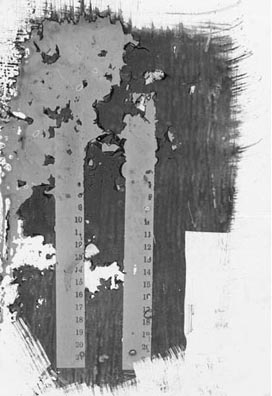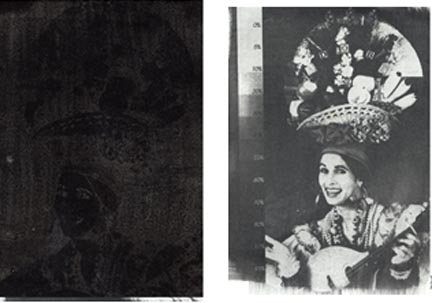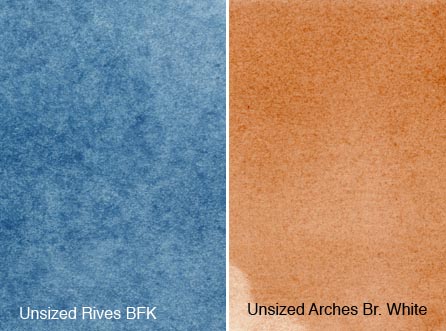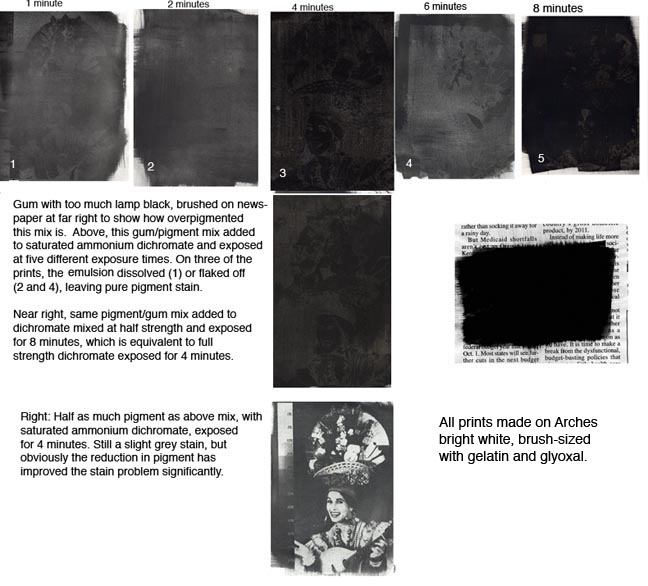
Marsh at Sunset. Gum bichromate. Copyright Katharine Thayer. Private Collection
Some of the most interesting gum prints, both past and present, owe at least some of their appeal to pigment stain. I'm not claiming, understand, that the print below is one of the most interesting gum prints ever made, but it's the one early print of mine that I have a slide of that has significant pigment stain. I've always loved this print and am sorry now that I sold it.

Marsh at Sunset. Gum bichromate. Copyright Katharine Thayer. Private Collection
Whether pigment stain is a bad thing and should be banished from a gum printer's work is a matter of individual taste; I personally don't think there should be any moral stigma attached to pigment stain. But that said, it's true that many if not most gum printers would prefer to avoid it, and that if my mail is any indication, this is the number one problem that beginning gum printers seek help for.
What is pigment stain? Pigment stain is what I call it when pigment lodges where it doesn't belong. Pigment stain consists of pigment only, (distinguishing it from fog, which is made of hardened gum containing pigment) and can take a number of different forms. One common form is a permanent indelible stain in paper, where the pigment sinks into the paper and stains the fibers irrevocably. This occurs more often on unsized papers, but can occur on sized papers as well, when pigment is used in excess.
The print above, for example, was printed on sized paper; I used so much red pigment that it permeated the sized paper, leaving a red cast in the image that turned the grass orange instead of yellow-green and the sky purple instead of blue. (The photograph was taken in the middle of a summer afternoon, not at sunset). But some pigment stain on well-sized paper can be wiped off, as can pigment stain on glass, which is why I have expanded my definition of pigment stain from the traditional definition of an indelible stain in paper to my present definition: pigment that is deposited where it doesn't serve the purpose of the image, whether it takes the form of an indelible stain or not.
Pigment stain can appear as specks, as a light color cast, as an overpowering mask of pigment that obscures the image completely, as I'll show in examples below, and in many intermediate forms. One of the most intriguing forms of pigment stain is an effect like tonal inversion.
What causes pigment stain?
There are two important causes of pigment staining: (1) overpigmentation of the coating mix, and (2) paper-related causes. In the example above: I got stain on sized paper; I reduced the pigment loads on the colors that were staining, the stain went away and stayed away even when I switched to printing on unsized paper. This was a pigment stain of type (1). But in printing on Arches bright white paper, as described in more detail below, I get a type of stain (speckles) when printing normal pigment loads on this paper, which is eliminated by sizing the paper. This is a pigment stain of type (2). I will treat each type in some detail below:
(1) The first cause of pigment staining is a pigment/gum ratio that's too high. If there's too much pigment in relation to gum, the excess pigment will settle out as pigment stain, in one form or another. If the gum is overpigmented, or under-gummed, you will get pigment deposited on the substrate, whether it's paper or glass, sized or unsized. Below see an example of pigment stain on glass, and on the page about tonal inversion, there is an example of stain on yupo, a plastic surface, and a number of examples of stain on well-sized paper.

Lamp Black printed on glass. (The hardened gum emulsion has failed to adhere completely in the upper left portion). The medium grey color is pigment stain.
Robert Demachy, the universally-acknowledged early gum master, said it this way: "If, on washing up, the paper shows a colour stain which cannot be removed by hot water..., the proportion of gum in the mixture has been too small... It is to be remembered that paper is always more or less stained by pure water color, and that it is the presence of gelatinous gum which prevents the colour from sinking and allows the total removal of the pigmented surface, leaving white, unstained paper behind. " (Maskell & Demachy, 1898). I don't agree with his characterization of gum as "gelatinous" and my experience and my definition of stain is broader than the indelible stain that can be created in unsized paper, as described above. But everything else he says there is consistent with my own experience: not enough gum in relation to pigment is an important cause of pigment stain.
They say a picture is worth a thousand words; here are two thousand words' worth. I printed a grossly overpigmented gum coating, resulting in severe pigment stain (on sized paper) and then I reduced the pigment in the coating mix by half and printed the same image again. (These are taken from a test described in greater detail below)

The image on the right is still somewhat pigment-stained, as you can see by the grey in the highlights; I would cut the pigment back a bit more for a perfect printing mix, but I think this comparison shows quite clearly how the proportion of pigment to gum relates to pigment staining.
Below I've taken two pigments, PR 175 and pthalo blue, which are two "staining" pigments, to illustrate this point.. On the left are two swatches of each, mixed to printing strength with gum arabic. On the right are two swatches of each, taken straight from the tube. I attempted to wipe away the bottom half of each of these swatches; the left swatch of each pair was wiped immediately after brushing the paint onto the paper; the right swatch of each pair was allowed to dry, then brushed and scrubbed with water and wiped dry.
The pigment mixed with gum to printing strength wiped away cleanly without scrubbing in both conditions (the bits of color remaining are not from stain, but from sloppy wiping) but the paint that wasn't mixed with additional gum stained badly, as the swatches on the right show clearly. And to make it clear that it's the amount of gum, not the amount of pigment that's the factor in the staining, notice the halo of stain at the bottom of the far right swatches. The water I used to rewet the dry paint, in each case, picked up some of the pigment and carried it outside the main swatch, creating a light tint of color, which immediately stained the paper and couldn't be scrubbed away. The jpegs don't show the stain very clearly, since it's fairly light, but believe me, it's there. This demonstration shows that whether a particular pigment stains paper or not is purely a matter of whether there is sufficient gum to hold it in suspension.
Some would say that it's not valid to show just the gum and pigment without the dichromate, but when the dichromate is added to the pigment-gum mix, the same principle continues to hold, confirming what Demachy said more than one hundred years ago, since the crucial variable that controls pigment staining is the gum, not the dichromate. I did some tests that confirmed that, some years ago; I prepared a series of 8 or 10 gum-pigment mixes at increasing pigment concentrations, each of the pigment/gum ratios prepared both with and without dichromate, and found that in my tests, staining occurred at the same gum-pigment ratio whether dichromate was added or not, and whether the dichromated coating was exposed or not. Unfortunately I've lost those test strips and don't have time to repeat that test now, as it's very time-consuming, but that's what I found, that the dichromate and the exposure had no significant effect on the staining property of the pigment-gum ratio. Not only this test but more importantly, years of printing experience without pigment stain bear out this principle: the ratio of gum to pigment largely affects whether a particular pigment mix stains or not.
"Tonal inversion" as a special case of pigment stain: One interesting manifestation of pigment stain is something that gum printers have come to call "tonal inversion." Because this phenomenon has puzzled gum printers and because I have a number of images related to this issue, I've made a separate page for it.
(2) Pigment stain can also be a function of paper or lack of sizing, even if the pigment is well within normal gum printing tolerances. Time was when I prided myself on being able to print multiple gum prints on almost any paper without sizing and without incurring stain, but more and more papers are becoming problematic for printing gum unsized. Here are a couple of papers that don't print well unsized, at least for me. Rives BFK has a reputation for being a good paper for beginners, and a good paper to print unsized, but this is one paper I have never been able to print reliably on, unsized. The blue below is a mix that prints quite nicely on other papers, but this is what happened when I printed it on BFK. There's actually an image printed on this sample, but it's completely obscured by the stain. In both of these cases, the stain is permanent and indelible, and became so as soon as the coating was brushed on the paper. It is because of paper effects such as this that most gum teachers recommend sizing paper as a rule.

I think it's useful to show a couple of different stained papers, because stain will take on different appearance depending on the character of the paper. BFK is a blotterlike paper with a lot of texture, and the stain shows all the hills and valleys in the paper, like a topographical map. The Arches Bright White, on the other hand, is a perfectly smooth paper. The specks you see aren't ups and downs in the paper, but flaws in the internal sizing, where the pigment is differentially absorbed. In Arches paper, these specks occur whether or not the pigment/gum ratio is out of limit, and that's why Arches papers must be sized in order to print gum without speckles. But in fact this particular pigment mix is overpigmented; it's the same mix that produced the tonal inversions in burnt umber on the tonal inversion page, and that's why there is an overall stain in addition to the speckles.
How can I avoid pigment stain? The solution for paper-related staining is to size the paper, or size it differently; the solution for stain related to overpigmentation is to work with your pigments until you find the printing range for each pigment which will print from pale to totally saturated without staining or producing other unwanted effects in the print. The pigment strength of pigments varies greatly from one pigment to the next, and even from one brand of a particular pigment to the next; the most frequent error made by beginning printers is to underestimate the strength of certain pigments, and/or to mix all pigments in the same proportion with gum.
You needn't fear that respecting gum's capacity for pigment will result in pale, anemic prints; gum can easily hold enough of any pigment to give you everything that particular pigment can give, understanding that because of differences in the strength and color saturation of different pigments, some can give more than others (for example, you'll never get the depth of tone from cobalt or cerulean blue that you can get from pthalo, no matter how much of it you use.) If you keep adding pigment beyond the point of maximum saturation for a given pigment, you will eventually reach the point where you get one or more of these effects: stain, inversion, or flaking off of the gum layer, or even all three.
Some gum teachers recommend that students use the "newspaper test" as a guide to proper pigmentation of the coating mix: if you couldn't read a newspaper through the brushed-out coating, it's probably too pigmented. While I'm not sure I would hold that rule as inviolable, it's not a bad rule to start with. At the bottom of the page you will see an example of how a very overpigmented mix looks when brushed over newspaper text; this one very clearly fails the newspaper test.
Other theories of pigment stain (or: What doesn't cause pigment stain?): My experience does not support the following theories promoted by others:
(1) that "too little" pigment relative to gum causes pigment staining (during one recent period in my work I was deliberately printing with so little pigment that the image could hardly be seen on the paper, without any staining resulting from this practice).
(2) that pigment stain is a function of dichromate concentration; the more dichromate, the more stain. Since I print fully saturated pigment mixes with full strength ammonium dichromate (the most concentrated dichromate used by gum printers) without stain, this claim is inexplicable to me.
The evidence given to support the claim by one gum printer that stain is a function of dichromate was that a gum mixture containing full strength ammonium dichromate was exposed for 4 minutes, and the same gum coating, except with the dichromate diluted to half strength, was exposed for 5 minutes, and developed for the same length of time; the print with half strength dichromate "cleared" and the print with full strength dichromate did not. The conclusion drawn was that the lack of clearing was due to stain.
But there's a simpler explanation. Exposure time, in my experience, varies linearly and inversely with dichromate concentration. In my tests, half the dichromate required twice the exposure time; 1/3 the dichromate required 3 times the exposure time; 1/5 the dichromate required 5 times the exposure time, as shown in my test results here. If the half-strength dichromate printed well at 5 minutes, then the saturated dichromate should have been printed for more like 2.5 minutes, instead of 4 minutes, to give it a comparable exposure.
Since the 4 minute test using saturated dichromate was most likely overexposed relative to the print using diluted dichromate, it stands to reason that it wouldn't have cleared as well as the print using the half-strength dichromate in the same amount of time, but chances are it would have cleared fine by the end of a longer development time; in other words the failure to clear is probably due to overexposure/underdevelopment and not related to stain per se.
In my experience, whenever gum printers have told me that dilute ammonium dichromate or potassium dichromate "doesn't stain as much" as saturated dichromate, further investigation has revealed that they haven't taken account of the shortness of the correct exposure for ammonium dichromate vs potassium or dilute ammonium dichromate, and have simply overexposed their prints with the more concentrated dichromate, and failed to develop longer to compensate for the overexposure. Below I've included a visual which fails to confirm the idea that pigment staining varies directly with dichromate concentration.
(3) that pigment stain is a function of exposure: the more exposure, the less stain. I've prepared a separate page showing a series of tests I ran which failed to support the idea that stain is related inversely to exposure, for paper-related stain. See those tests here.
As for pigment-related stain, below is an overpigmented mix of lamp black exposed at five different exposure times. As you can see, stain is stain; all five of the prints are heavily stained, which doesn't support the idea that stain varies with exposure. In three of the prints, the gum emulsion flaked off completely due to the excess pigment load, leaving pure pigment stain behind; in the other two, the gum coating remains, but is so pigment-stained that no image can be seen. Below (third row) I added gum to dilute the pigment to half the concentration, everything else held constant, and exposed it for 4 minutes. There is still a bit of grey stain in the highlights, but you can see clearly that the reduction in pigment has a dramatic effect on the stain.
This visual also (second row) includes a comparison of half-strength dichromate to full-strength dichromate, keeping the pigment/gum ratio constant; in other words this comparison addresses theory (2) above, that says pigment stain is a function of dichromate concentration, not a function of pigment/gum ratio. As you can see, reducing the dichromate has no effect whatever on the stain, but reducing the ratio of pigment to gum has a dramatic effect on the stain, confirming Demachy, Crawford, Scopick and all the other greats, besides little me, who have affirmed over the decades that pigment stain is a function of the ratio of pigment to gum. Not everyone agrees with us about this, but I am not here to argue with anyone, only to say what works for me. This principle works for me, and understanding it and respecting it has allowed me to print stain-free for years.

We don't understand all the complexities of stain, "tonal inversion" and flaking off of too-pigmented emulsion, for example we don't fully understand in what order these phenomena appear as the coating is made progressively overpigmented, or whether different pigments behave differently in this regard, (for example I don't know at what degree of overpigmentation a coating will flake off and leave white paper beneath, and at what point it will flake off and leave stain below, or if different pigments behave differently in that regard) but the main thing to remember is this: If you overload gum with pigment beyond its capacity to hold it, weird and often unpleasant things tend to happen. If you don't overload the gum with pigment, you'll still be able to print as dark as the pigment will allow, you won't get staining or tonal inversions, your emulsions will stay put rather than flaking off, and you'll be happier with your results. That's how it looks to me; that's how it works for me.